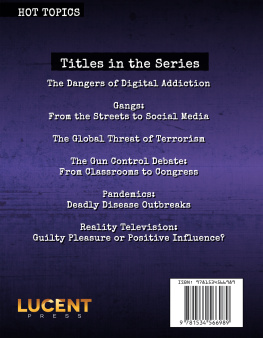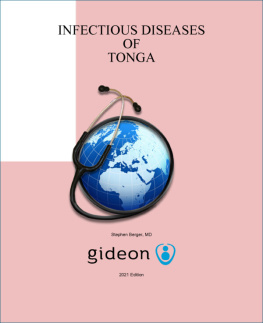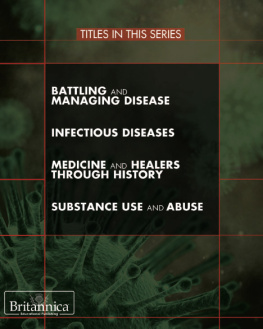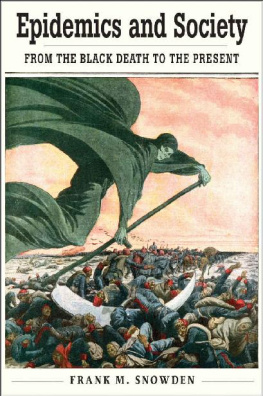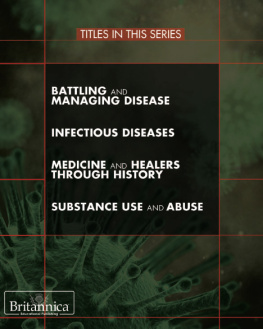Twelve Diseases That Changed Our World
Irwin W. Sherman
ASM Press
Address editorial correspondence to ASM Press, 1752 N St. NW, Washington, DC 20036-2904, USA
Send orders to ASM Press, P.O. Box 605, Herndon, VA 20172, USA
Phone: (800) 546-2416 or (703) 661-1593
Fax: (703) 661-1501
E-mail:
Online: estore.asm.org
Copyright 2007ASM Press
American Society for Microbiology
1752 N Street NW
Washington, DC 20036-2904
Library of Congress Cataloging-in-Publication Data
Sherman, Irwin W.
Twelve diseases that changed our world / Irwin W. Sherman.
p. ; cm.
Includes bibliographical references and index.
ISBN 978-1-55581-466-3 (alk. paper)
1. EpidemicsHistory. 2. Diseases and history. I. Title.
[DNLM: 1. Disease Outbreakshistory. 2. Communicable Disease Controlhistory. 3. Communicable Diseaseshistory. 4. History, Early Modern 14511600. 5. History, Medieval. 6. History, Modern 1601-. 7. Socioeconomic Factors. WA 11.1 S553t 2007]
RA649.S44 2007
614.4dc22 2007023680
10 9 8 7 6 5 4 3 2 1
All Rights Reserved
Printed in the United States of America
Cover: Plague in Rome , Jules Elie Delaunay (18281891). Courtesy Wellcome Library, London.
Contents
Preface
The literature on the impact of disease on history is large. It chronicles how illness has affected Western civilizations: in the 14th century plague broke the Malthusian stalemate and provided the impetus to restructure European societies; during the past two centuries genetic diseases altered the fates of the British, Spanish, and Russian royal families and contributed to the rise of Lenin, Franco, and Hitler; in the last 100 years we have witnessed how increased opportunities for disease transmission have decimated populations, created panic, and fostered discrimination. We continue to be painfully aware of the power a disease can wield in effecting social and political changes on a grand scale and how it can reveal and exacerbate social tensions. In the past, disease played a role in colonial expansion in the Americas and Africa and, through demographic pressure and starvation, forced a mass migration of the Irish people; tomorrow in different places and in different ways, another disease may do the same.
Historical perspectives of disease can be valuable for a better understanding of how we, and our forebears, survived the onslaught of plagues and how we might avoid some of their consequences: confrontations between immigrants and nativists, discrimination against those with different lifestyles, and the social and political disruptions due to incapacitation and death. Of equal value, and much needed, is an examination of the attempts to control disease and how it was possible to improve the public health. In short, this book is about the lessons we have or should have learned from our past encounters with unanticipated outbreaks of disease and how such understanding can be put to use when future outbreaks occur.
The recent SARS and AIDS pandemics clearly show that our lives, as well as the political and economic fortunes of the developed world and emerging nations, can be influenced by the appearance of a contagious disease. In 2004, alarm bells went off as avian influenza spread across the globe, killing millions of domestic fowl and 113 people. The public asked what measures would be needed to stop its spread so that another 1918 to 1920 flu pandemic, which killed tens of millions of people, would not occur. In 2006 cholera swept through West Africa, striking 20,000 people, and in the United States mumpsno longer thought to be a threat because of childhood vaccinationbroke out in Iowa and quickly spread to neighboring states, affecting 1,000 people.
These unanticipated epidemics provoke questions. What is needed to curtail the transmission of a disease? What will it take to contain a disease so that protective measures can be instituted? These questions, perplexing and complex, need answers. To simply catalog past diseases and tell of their historic consequences would not be of lasting value to the general public. Rather, it was my feeling that the answers to how we might deal with coming plagues could be better obtained by an examination of how past encounters with disease allowed for better control and improved health.
Our world has experienced so many diseases that it would be pointless to deal with all of them. In fact, it would be a nearly impossible task, and, if achieved, it would be numbing to read. Instead, I have selected a dozen diseases that have shaped our history and illuminated the paths taken in finding measures to control them. Porphyria and hemophilia ()continue to elude control. In this book I try to answer why this is so.
The message of this book is simple: understanding past outbreaks of disease can better prepare us for those in our future. The twelve diseases chosen have influenced the way we look at sickness and show how they resulted in public health measures and other interventions to stem the spread of that disease and others. To eliminate the fear and confusion surrounding coming plagues, I describe the ways we have succeeded in bringing certain diseases under control and, in other cases, our failures. My purpose in writing this book for the general reader is to show that despite the challenges which an unanticipated illness may place before us, the future is not without hope or remedy.
The Legacy of Disease: Porphyria and Hemophilia
In 1962 the U.S. President John F. Kennedy said, Life is unfair. Some people are sick and others are well. He, of course, was referring to himself and the persistent rumors about his ill health. Forty years later, an examination of his medical records revealed that he had Addison's disease, a life-threatening lack of adrenal gland function, as well as osteoporosis and persistent digestive problems. He was given pain killers (demerol and methadone), stimulants, and antianxiety agents, as well as hormones (hydrocortisone and testosterone) to keep him alive, especially during times of stress. Although doubts linger whether President Kennedy's physical ailments influenced the manner by which the Cuban missile crisis was handled or whether they affected other political decisions, it is clear that for many world leaders, including Great Britain's King George III, several of Queen Vizctoria's children and grandchildren, Tsar Nicholas II of Russia, and Alfonso XIII and Generalissimo Franco in Spain, as well as, indirectly, the leaders of Nazi Germany, sickness was the seed for historical change.
Porphyria
Madness in the monarchy
Mary Queen of Scots (1542 to 1587) had a mysterious ailment. At the age of 24 she wrote, Oftentimes I have great pains... ascending unto my head... it descends to my stomach so that it makes me lack an appetite... and there is sickness with great vomit... excuse my writing, caused by the weakness of my arm... wherewith we are tormented. In 1570, when she had another attack, her symptoms were described by her physician: terrible pains in the side made worse by every movement, even breathing. She vomited continuously, more than 60 times, and eventually brought up blood. She became delirious, and two days later she lost her sight and speech, had a series of fits, remained unconscious for some hours and was thought to be dead. Yet within 10 days she was up and about again. She had unquiet and melancholy fits, convulsions, shivering, difficulty in swallowing, altered voice, weakness of arms and legs so that she could neither write, walk or even stand unaided. The onset of her symptoms was rapid and suggested to some in her court that she was being poisoned. Others judged her to be hysterical. It is most likely, however, that Mary Queen of Scots was neither hysterical nor the victim of poisoning. Instead, she and many of her descendants probably suffered from an inherited disordera curse of British royaltythat would alter the course of world history.


